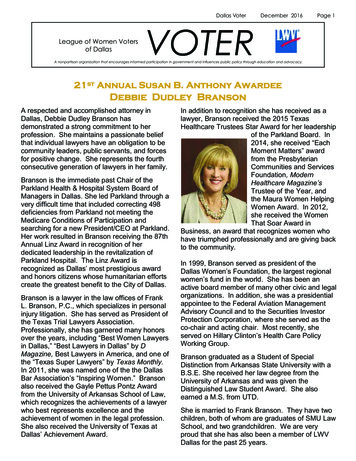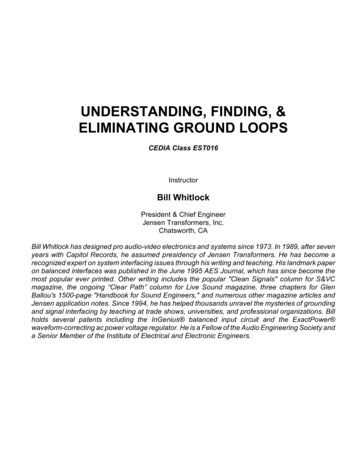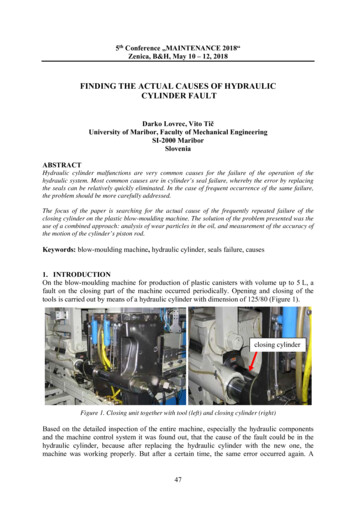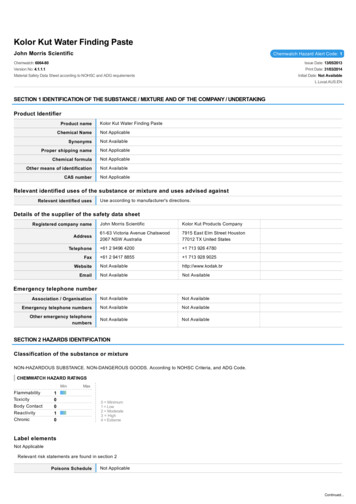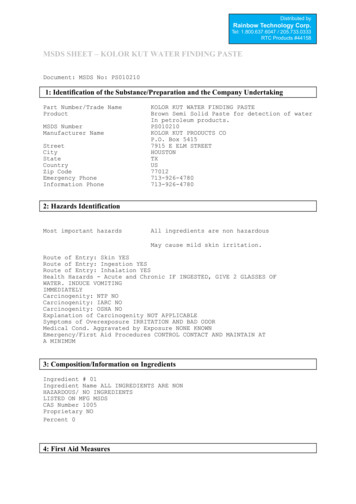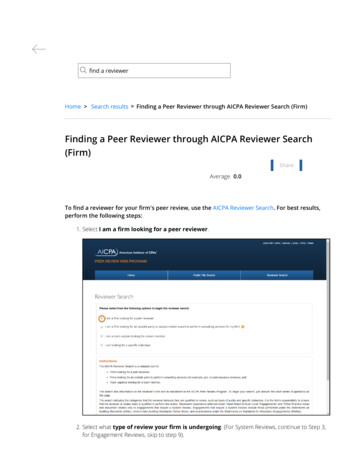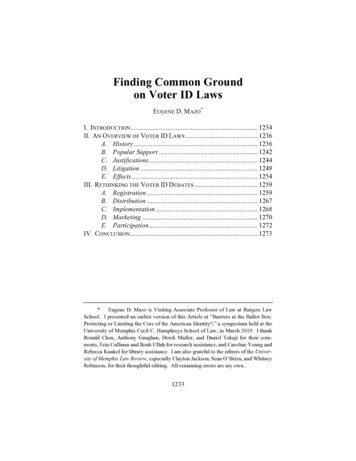
Transcription
Finding Common Groundon Voter ID LawsEUGENE D. MAZO*I. INTRODUCTION . 1234II. AN OVERVIEW OF VOTER ID LAWS . 1236A. History . 1236B. Popular Support . 1242C. Justifications . 1244D. Litigation . 1249E. Effects . 1254III. RETHINKING THE VOTER ID DEBATES . 1259A. Registration . 1259B. Distribution . 1267C. Implementation . 1268D. Marketing . 1270E. Participation . 1272IV. CONCLUSION . 1273*Eugene D. Mazo is Visiting Associate Professor of Law at Rutgers LawSchool. I presented an earlier version of this Article at “Barriers at the Ballot Box:Protecting or Limiting the Core of the American Identity?,” a symposium held at theUniversity of Memphis Cecil C. Humphreys School of Law, in March 2019. I thankRonald Chen, Anthony Gaughan, Derek Muller, and Daniel Tokaji for their comments, Erin Cullinan and Ikrah Ullah for research assistance, and Caroline Young andRebecca Kunkel for library assistance. I am also grateful to the editors of the University of Memphis Law Review, especially Clayton Jackson, Sean O’Brien, and WhitneyRobinson, for their thoughtful editing. All remaining errors are my own.1233
1234The University of Memphis Law ReviewI.Vol. 49INTRODUCTIONA sizable number of Americans believe that voter fraud occurs.1To combat voter fraud—or at least the perception that it exists—manystates have recently enacted laws that impose documentary identification requirements on their voters. These so-called “voter ID laws” typically require a citizen to prove his identity with a government-issuedID before he can cast his ballot. Such voter ID laws come in variousguises and are currently in force in thirty-five states.2 In most states,these laws, which have been enacted along strictly partisan lines, havebeen divisive and controversial.3 Our political parties see the worlddifferently when it comes to voter ID requirements. Republicans tendto be concerned with election integrity and claim that voter ID laws arenecessary to prevent fraud. Democrats liken voter ID laws to the polltaxes and literacy tests of the past and claim these laws disenfranchiseminorities, the elderly, and the poor.4 Because the perceptions of voter1. Emily Guskin & Scott Clement, Poll: Nearly Half of Americans Say VoterFraud Occurs Often, WASH. POST (Sept. 15, 2016), ud-occurs-often/?tid sm tw pp&wprss rss the-fix.2. See Voter ID Requirements, NAT’L CONF. ST. LEGISLATURES (Jan. 17,2019), ns/voter-id.aspx.3. See Joyce Purnick, Stricter Voting Laws Carve Latest Partisan Divide,N.Y. TIMES (Sept. 26, 2006), oting.html (describing the controversy behind voter ID requirements); Peter Wallsten,Parties Battle over New Voter ID Laws, L.A. TIMES (Sept. 12, -sep-12-na-voting12-story.html.4. There has been a great deal of commentary noting the divisiveness andpartisanship of these laws. See, e.g., RICHARD L. HASEN, THE VOTING WARS: FROMFLORIDA 2000 TO THE NEXT ELECTION MELTDOWN 1959 (2012) (arguing that “Democrats . . . are much less likely to be interested in purging voter rolls of potentiallyineligible voters than Republicans are. Democrats worry about disenfranchising eligible voters; Republicans worry about the potential for fraud from bloated voterrolls.”); MARTHA KROPF & DAVID C. KIMBALL, HELPING AMERICA VOTE: THE LIMITSOF ELECTION REFORM 5 (2012) (explaining how “Republicans tend to be more interested in measures to prevent fraud, which may reduce voter turnout, while liberals andDemocrats tend to be more concerned about removing barriers to voting and increasing turnout.”); Derek T. Muller, What’s Old Is New Again: The Nineteenth CenturyVoter Registration Debates and Lessons About Voter Identification Disputes, 56WASHBURN L.J. 109, 109 (2017) (noting how “[t]hese laws have largely been promulgated by Republicans and target election fraud—real or perceived—in an attempt torestore some integrity to the electoral process. Democrats . . . have opposed these
2019Finding Common Ground on Voter ID Laws1235fraud and the conclusions about the effects of voter ID laws differ between Republicans and Democrats, voter ID laws have been the subjectof intense debate during the last several election cycles. They have alsobeen subject to multiple court challenges. Even so, there is little evidence that the partisan rhetoric on either side of the aisle is at all subsiding.To move the conversation forward, this Article seeks to forge anew path. Part II presents a picture of America’s current voter ID landscape. It recounts the history of voter ID laws in the United States,looks at their justifications, and probes their popular support. It alsodiscusses the litigation involving these laws and examines the scholarlyliterature concerning their effects. Some of this literature suggests thatthese laws might have less impact than is commonly believed, both interms of preventing voter fraud and in terms of suppressing turnout.5As such, Part III explores how the proponents and opponents of voterID laws could be brought together to achieve their common goals.These goals are to protect the integrity of American elections while notmaking it any more difficult for ordinary citizens to participate in thedemocratic process. Part III offers a proposal for how these twin goalscould be achieved with a voter ID requirement.First, any state mandating a voter ID requirement would have toagree to take on the burden of providing voter IDs free of charge to allcitizens when they register to vote, and it would have to ease the barriers to voter registration. The state’s goal in doing so would be tobroaden the electorate in the short and long term. Second, the statewould have to make sure that its voter ID requirement was populationneutral. This means the requirement would have to be designed so thatit does not discriminate against any group.6 Third, states requiringlaws and often critiqued them as a kind of voter suppression tactic, one that disproportionally burdens racial minorities, the poor, and those who have recently movedinto a precinct.”).5. See Ross Douthat, The Myths of Voter ID, N.Y. TIMES (Feb. 12, oter-id-study-republicans-democrats.html.6. A sizable literature addresses the ways in which voter ID laws in the statesdiscriminate or are biased against various groups in American society. See, e.g., AtibaR. Ellis, The Cost of the Vote: Poll Taxes, Voter Identification Laws, and the Price ofDemocracy, 86 DENV. U. L. REV. 1023, 1026 (2009) (arguing that voter ID laws discriminate by socioeconomic status); Sally Harrison, Comment, May I See Your ID?:How Voter Identification Laws Disenfranchise Native Americans’ Fundamental Right
1236The University of Memphis Law ReviewVol. 49voter IDs would have to take steps to ensure that voters who lose orforget their IDs have a safety net and that there is still a way for themto cast a ballot, if they can later prove their identity. The best way fora state to implement all of these reforms would be to delay the implementation of its voter ID requirement until after it runs a multi-yearmarketing and public relations campaign educating its citizens aboutits new requirement. In short, this Article argues that voter ID lawsshould be used to enlarge, rather than restrict, a state’s voting electorate, and ultimately, to strengthen a state’s democratic base.II. AN OVERVIEW OF VOTER ID LAWSA. HistoryIn an effort to make voting easier for Americans, Congresspassed the National Voter Registration Act of 1993 (“NVRA”),7 a statute that commonly came to be known as the Motor Voter Law.8 Itsnickname derived from the statute’s mandate that individual states hadto provide an opportunity for citizens to register to vote when they applied for a driver’s license at a state motor vehicle office.9 In additionto this well-known requirement, the NVRA required states to acceptnew voter registration applications by mail,10 mandated states to keepaccurate registration lists of voters who had voted in federal elections,and made it difficult for states to remove voters from these lists for notto Vote, 37 AM. INDIAN L. REV. 597, 597 (2013) (arguing that voter ID laws discriminate against Native Americans); Matthew Petruszak, Note, Thinning the Gray Vote:State Voter Identification Laws and the Nation’s Elderly, 23 ELDER L.J., 227, 228(2015) (arguing that voter ID laws discriminate against the elderly).7. National Voter Registration Act of 1993, Pub. L. No. 103-31, 107 Stat. 77(originally codified as amended at 42 U.S.C. §§ 1973gg–1973gg-10 (2012), currentlycodified as amended at 52 U.S.C. §§ 20501–20511 (2012 & Supp. 2015)).8. See About the National Voter Registration Act, U.S. DEPT. OF oter-registration-act (last updated Aug. 5,2015) (“Congress enacted the National Voter Registration Act of 1993 (also knownas the ‘NVRA’ and the ‘Motor Voter Act’), to enhance voting opportunities for everyAmerican.”); see also National Voter Registration Act of 1993, 52 U.S.C. § 20504(2012 & Supp. 2015).9. About the National Voter Registration Act, supra note 8.10. Id.
2019Finding Common Ground on Voter ID Laws1237voting.11 The NVRA also enforced safeguards under which registeredvoters retained the right to vote even if they happened to move.12 Under the NVRA, a voter who relocated within a state or voting precinctretained his right to vote in federal elections even if he did not re-register with the state at his new address.13The NVRA’s mandate to make voting open to persons who mayhave registered by mail, combined with its prohibition on removingcertain voters’ names from state voter registration lists, caused severalstate legislatures to argue that Congress’s new federal law compromised the integrity of state elections and curtailed the ability of thestates to prevent fraud.14 State voter registration lists began to swell,as they now contained the names of people that the states could nolonger remove. This made some of the state registration lists less accurate.15 Several states began to worry that they would not be able toidentify voters who showed up at the polls on Election Day.16Several years after the NVRA’s adoption, the 2000 presidentialelection put the issue of how elections are administered on the nationalradar and made voting a topic of national concern. In the wake of Bushv. Gore, the Supreme Court decision that ended Florida’s electoral voterecount and effectively handed the presidency to George W. Bush,17Congress began to take election reform more seriously. The Florida11. See 52 U.S.C. § 20507(a)–(d) (2012 & Supp. 2015). Removal of a voterfrom a registration list could only be done after meeting certain requirements providedin the NVRA. For example, the law allowed for voters to be removed from registration lists after they have been convicted of a crime or adjudged mentally incapacitated.Id. § 20507(a)(3)(A).12. See id. § 20507(c)–(d).13. Id.14. See LARRY J. SABATO & GLENN R. SIMPSON, DIRTY LITTLE SECRETS: THEPERSISTENCE OF CORRUPTION IN AMERICAN POLITICS 321–22 (1996); Samuel P. Langholz, Note, Fashioning a Constitutional Voter-Identification Requirement, 93 IOWAL. REV. 731, 744 (2008).15. See Langholz, supra note 14, at 744 (“With the limits NVRA places onstates’ ability to ensure the integrity of their voter-registration lists, the lists have become bloated with the names of people who have moved, died, committed felonies,or never existed in the first place . . . .”).16. ERIC A. FISCHER ET AL., CONG. RESEARCH SERV., R42806, STATE VOTERIDENTIFICATION REQUIREMENTS: ANALYSIS, LEGAL ISSUES, AND POLICYCONSIDERATIONS 1–2 (2016).17. 531 U.S. 98 (2000).
1238The University of Memphis Law ReviewVol. 49election debacle of 2000 shook people’s confidence in the nation’selectoral system. In 2002, Congress responded by passing the HelpAmerica Vote Act (“HAVA”), another federal statute aimed at improving the administration of elections.18 HAVA imposed various new requirements on the states, including a limited new voter ID requirement.19 Specifically, HAVA mandated that an individual whoregistered to vote in a federal election by mail now had to present avalid photo ID before he could cast his ballot, whether in person or bymail.20 HAVA also made it clear that states could adopt more stringentvoter ID requirements of their own.21Only fourteen states had voter ID laws in place in 2000.22 In1950, South Carolina became the first state to require that its votersshow a form of identification at the polls when voting.23 The documentdid not have to be a photo ID card; rather, any document bearing thevoter’s name would suffice.24 In 1970, Hawaii followed South Carolina.25 Texas then did so in 1971, Florida in 1977, and Alaska in 1980.26In these states, provisions existed for a voter to cast a regular ballot18. Help America Vote Act of 2002, Pub. L. No. 107-252, 116 Stat. 1666 (origina
Finding Common Ground on Voter ID Laws EUGENE D. MAZO* I. INTRODUCTION. 1234 II. A N OVERVIEW OF VOTER ID LAWS . sity of Memphis Law Review, especially Clayton Jackson, Sean O’Brien, and Whitney Robinson, for their thoughtful editing. All remaining errors are my own. 1234 The University of Memphis Law Review Vol. 49 I. INTRODUCTION A sizable number of Americans
